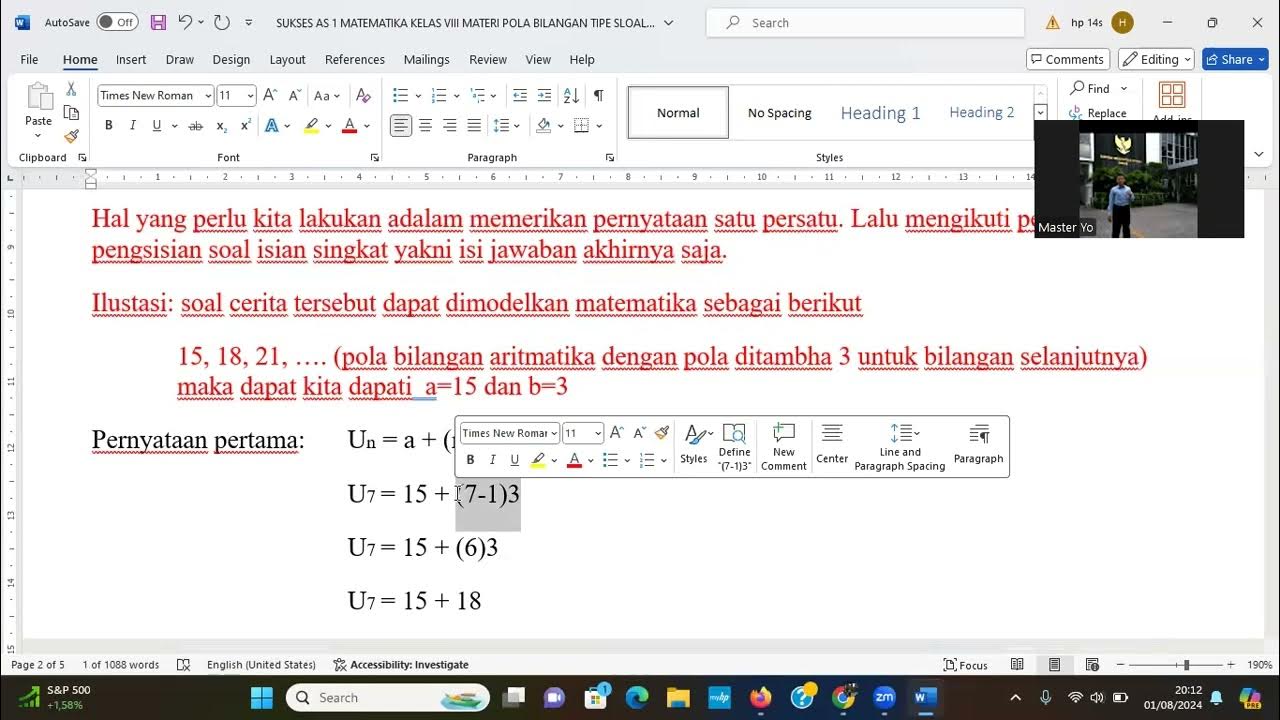Asesmen Sumatif Melalui Diferensiasi Produk
Summary
TLDRThe video script discusses a summative assessment practice in a first-grade elementary school math class, focusing on understanding tiling patterns and the ability to create flat shapes for tiling. It emphasizes the importance of identifying students' initial knowledge and using probing questions to assess their learning needs. The script outlines steps for implementing a summative assessment with various products, including introducing concrete examples, creating an evaluation rubric, and guiding students through the assessment process. It encourages teachers to be creative in designing learning experiences tailored to individual students' needs and learning outcomes.
Takeaways
- 📚 The script is about a summative assessment practice in a first-grade elementary school math class focused on understanding the concept of tiling and creating flat shapes to form patterns.
- 🔍 It emphasizes the importance of understanding the meaning of tiling, which is a collection of flat shapes arranged neatly without gaps or overlaps.
- 🤔 The teacher encourages students to recall and discuss the concept of tiling, highlighting the need for a collective understanding of the term and its characteristics.
- 🏫 The script mentions the teacher's role in identifying students' learning needs by using probing questions to assess their initial knowledge and readiness to learn.
- 📝 The teacher is advised to present concrete examples and open discussions to facilitate students' understanding of the concept of tiling.
- 👀 The script provides an example of a classroom application where students are asked to identify and discuss the shapes used in the classroom's tiling.
- 📐 It distinguishes between different types of flat shapes, such as triangles and rectangles, and discusses the characteristics that make a shape suitable for tiling.
- 📋 The creation of an assessment rubric is highlighted as a key step in the summative assessment process, based on the competencies of each student, learning objectives, and learning outcomes.
- 📝 Students are guided through the assessment process, with the teacher providing instructions and criteria based on the rubric for creating the final product of the learned material.
- 🎨 The script suggests offering students freedom in choosing materials for their tiling projects, such as origami paper, coloring tools, or magnetic flat shapes, to cater to individual learning needs.
- 🌟 The teacher is challenged to be creative in designing learning experiences that are tailored to the needs, learning objectives, and achievement goals of each student during a specific period.
Q & A
What is the main purpose of the assessment activity described in the script?
-The main purpose of the assessment activity is to help students understand the concept of tiling patterns and to be able to create flat shapes to form tiling patterns.
What is the definition of 'tiling' according to the script?
-Tiling is defined as an arrangement of flat shapes that has no gaps, no overlaps, and can consist of one or more shapes.
How does the script suggest educators identify the learning needs of the students?
-The script suggests educators identify learning needs by asking probing questions to understand the students' initial knowledge and readiness to learn, which will help in understanding their level of comprehension.
What is an example of a concrete example provided by the script for tiling?
-The script provides the classroom walls and floor as examples of tiling, which consist of flat shapes like triangles and rectangles without gaps or overlaps.
How can the classroom walls and floor be used to teach the concept of tiling?
-The classroom walls and floor can be used as concrete examples for students to observe and discuss the shapes involved in tiling, helping them understand the concept better.
What is the significance of creating a rubric for the summative assessment?
-Creating a rubric helps to evaluate students based on their competencies, learning objectives, and achievements during a specific period, providing a structured way to measure their understanding of tiling.
What are the different stages of development mentioned in the rubric for students' tiling skills?
-The stages include: initial development where students can arrange flat shapes but may have overlaps and gaps; intermediate development where students can create tiling with one type of shape; and advanced development where students can create complex tiling patterns with multiple shapes meeting the tiling criteria.
How does the script suggest giving students freedom in the summative assessment task?
-The script suggests allowing students to choose the materials they want to use for their tiling, such as origami paper, coloring tools, or magnetic flat shapes, giving them the freedom to determine their learning needs.
What challenges might educators face when implementing a summative assessment with various products?
-Educators might face challenges such as the need to be creative in designing learning experiences that cater to the needs of each student, align with learning objectives, and measure learning achievements effectively.
How can differentiation be applied in the summative assessment as suggested by the script?
-Differentiation can be applied by allowing each student to produce different results in the assessment, with the educator referring to the rubric to evaluate the uniqueness and correctness of each student's tiling pattern.
What is the final message conveyed by the script for educators implementing the summative assessment?
-The final message is to encourage educators to apply the summative assessment with various products to measure student development and guide them in planning future learning activities.
Outlines

This section is available to paid users only. Please upgrade to access this part.
Upgrade NowMindmap

This section is available to paid users only. Please upgrade to access this part.
Upgrade NowKeywords

This section is available to paid users only. Please upgrade to access this part.
Upgrade NowHighlights

This section is available to paid users only. Please upgrade to access this part.
Upgrade NowTranscripts

This section is available to paid users only. Please upgrade to access this part.
Upgrade NowBrowse More Related Video

Tiling Window Managers Are Just A Waste Of Time

Latihan Soal Pola Bilangan

Perencanaan Pembelajaran - Merancang Asesmen Pembelajaran SMP

Snapshots: Best Practices In Math Instruction

Simulasi Pembelajaran Kelas Rangkap (PKR) || Model 221 || Universitas Terbuka

Polonium Kind Of Turns KDE Into A Real Tiler
5.0 / 5 (0 votes)